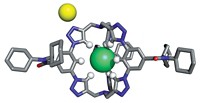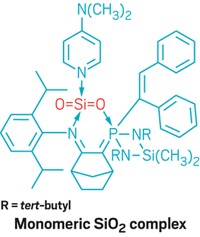Advertisement
Grab your lab coat. Let's get started
Welcome!
Welcome!
Create an account below to get 6 C&EN articles per month, receive newsletters and more - all free.
It seems this is your first time logging in online. Please enter the following information to continue.
As an ACS member you automatically get access to this site. All we need is few more details to create your reading experience.
Not you? Sign in with a different account.
Not you? Sign in with a different account.
ERROR 1
ERROR 1
ERROR 2
ERROR 2
ERROR 2
ERROR 2
ERROR 2
Password and Confirm password must match.
If you have an ACS member number, please enter it here so we can link this account to your membership. (optional)
ERROR 2
ACS values your privacy. By submitting your information, you are gaining access to C&EN and subscribing to our weekly newsletter. We use the information you provide to make your reading experience better, and we will never sell your data to third party members.
Physical Chemistry
Cyanoformate Structure Could Aid Efforts To Trap Carbon Dioxide
Unstable Complex: Elusive ion’s unusual bonding could inform design of agents that capture greenhouse gas
by Celia Henry Arnaud
April 3, 2014
| A version of this story appeared in
Volume 92, Issue 14

For such a seemingly simple ion, cyanoformate (NCCO2−) has been tough to catch. But scientists have now trapped the fleeting anion. The achievement could guide the design of agents that capture the greenhouse gas carbon dioxide.
Jason A. C. Clyburne of Saint Mary’s University, in Halifax, Nova Scotia, and coworkers captured cyanoformate as a tetraphenylphosphonium salt and obtained its crystal structure (Science 2014, DOI: 10.1126/science.1250808 ).
The structure shows that the anion is a Lewis acid base adduct in which the carbon from cyanide donates a pair of electrons to the carbon in CO2. “It’s a donor-acceptor complex between a base and an acid,” Clyburne says. “But it forms only a very weak carbon-carbon bond,” adds Heikki M. Tuononen of the University of Jyväskylä, in Finland, whose research group examined the electronic structure of the anion with theoretical methods.
Cyanoformate “is as reactive and as unstable and as sensitive a molecule as I’ve ever isolated,” Clyburne says. “Cyanide is a stable entity, and CO2 is a stable entity. Yet, under the right conditions we can pair them, isolate the complex, and study its decay.”
Clyburne and coworkers also stabilized another salt of the anion in an ionic liquid. By using different solvents, they were able to study the anion’s degradation as a function of the dielectric constant of the solution. “The chemistry of CO2 is significantly different in low-dielectric media,” Clyburne says.
In the anion, “cyanide is only barely able to hold onto the CO2,” says Philip G. Jessop, a professor at Queen’s University, in Kingston, Ontario, and technical director of GreenCentre Canada. That weak binding means the work could inspire new strategies for capturing CO2 from power plant emissions.
“If or when society decides to do something about global warming, work like that of Clyburne will be crucial to the design of the most energy-efficient CO2 scrubbing agent,” Jessop says. “In that process, one needs something to bind CO2 but not bind it too strongly, so that release of the CO2 is easy when the binding agent needs to be regenerated.”





Join the conversation
Contact the reporter
Submit a Letter to the Editor for publication
Engage with us on Twitter